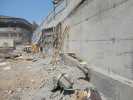The Ferris wheel with a diameter of 75m in Gelendzhik
In order to align the settlements of a structure lockated on the base with uneven compressibility of soils, rigid foundations are necessary. Thin plates bend, following the displacement, and thick ones have a large own weight. Studies in the field of «ribbing» of slabs show the way of creating effective structures. However, for the device of upwards directed edges a formwork is necessary. Such diafragms make it difficult to use the volume of rooms. In clay soils, capable of holding vertical trench walls, it is more efficient to arrange slabs with diafragms directed downward. The system of such diafragms combined with a relatively thin plate will allow to obtain a plate foundation whose rigidity will be adjusted taking into account the distribution of loads and the compliance of the base, the frequency and the configuration of the ribs. For many structures, the unevenness of the deformation of the base is caused by the nature of the load and its distribution.
For the Ferris wheel with a diameter of 75m, which was erected in the city of Gelendzhik, Krasnodar Territory, the most significant load is certainly the wind load.
In this case, extremely stringent requirements are imposed on the foundation for the 1 and 2 groups of limiting states. The structure of the foundation must compensate for uneven deformation of the basement under the action of wind load, prevent the formation of heeling, and also satisfy the necessary conditions for strength and crack resistance.
The basement of the foundation is the the fundamental weathered and gloriously weathered rocks represented by the rhythmic alternation of strong thick-plate marls with clayey marls and thin interlayers of sandstones.
In this regard, a number of numerical experiments were conducted to determine the optimal structure of the foundation. A constructive scheme of the foundation was proposed in the form of a plate with stiffeners arranged down to the greatest possible depth of ~ 2 m. The optimal pitch, thickness and configuration of the fins were determined.
The proposed scheme proved to be more rational in comparison with the previously chosen massive foundation plates of large thickness. The device of stiffeners allowed to fulfill the requirements of limiting states for all structural elements.
As a result, the foundation was designed in the form of a continuous slab with a thickness of 600 mm made of concrete of class B25 with longitudinal and transverse monolithic ribs 1000 mm and 800 mm thick, respectively.
For the Ferris wheel with a diameter of 75m, which was erected in the city of Gelendzhik, Krasnodar Territory, the most significant load is certainly the wind load.
In this case, extremely stringent requirements are imposed on the foundation for the 1 and 2 groups of limiting states. The structure of the foundation must compensate for uneven deformation of the basement under the action of wind load, prevent the formation of heeling, and also satisfy the necessary conditions for strength and crack resistance.
The basement of the foundation is the the fundamental weathered and gloriously weathered rocks represented by the rhythmic alternation of strong thick-plate marls with clayey marls and thin interlayers of sandstones.
In this regard, a number of numerical experiments were conducted to determine the optimal structure of the foundation. A constructive scheme of the foundation was proposed in the form of a plate with stiffeners arranged down to the greatest possible depth of ~ 2 m. The optimal pitch, thickness and configuration of the fins were determined.
The proposed scheme proved to be more rational in comparison with the previously chosen massive foundation plates of large thickness. The device of stiffeners allowed to fulfill the requirements of limiting states for all structural elements.
As a result, the foundation was designed in the form of a continuous slab with a thickness of 600 mm made of concrete of class B25 with longitudinal and transverse monolithic ribs 1000 mm and 800 mm thick, respectively.
Figure 1. Scheme of the base of the observation wheel in the form of a plate with downwardly arranged stiffeners
The results of the calculations carried out for the proposed structural design of the foundation allowed us to determine the reinforcement in the longitudinal and transverse diafragms of rigidity, as well as in the foundation slab. Figure 2 shows the stages of construction.
Figure 2. Ferris wheel D = 75m in Gelendzhik, Krasnodar Region 1) Stage of construction of the foundation; 2) Stage of assembly of wheel structures



















































